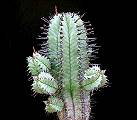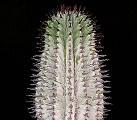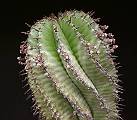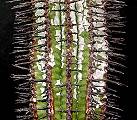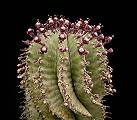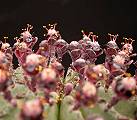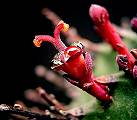|
Euphorbia polygona Haworth |
|
|
Fotos |
1 Wuchsform (ML) 2
Wuchsform (ML) 3 Stamm 4
Stamm 5 Stamm 6 Stamm mit abblätternder
Wachsschicht 7 Stamm mit Cyathien 8
Cyathien 9 Cyathium |
|
Photos |
1 Growth form (ML)
2 Growth form (ML) 3
Stem 4 Stem 5 Stem 6 Stem with peeling wax layer 7
Stem with cyathia 8 Cyathia 9
Cyathium |
|
Erstbeschreibung |
Haworth 1803, Misc. Nat.
184 |
|
Initial
description |
|
|
Heimat |
RSA (Eastern Cape) |
|
Habitat |
RSA (Eastern Cape) |
|
Wuchsform |
|
|
Growth
form |
|
|
Cyathien |
|
|
Cyathia |
|
|
Kalender |
|
|
Calendar |
|
|
Kultivierung |
|
|
Cultivation |
|
|
Min. Temperatur |
6 °C |
|
Min. temperature |
43 °C |
|
Schädlinge &
Krankheiten |
(keine beobachtet) |
|
Pests and diseases |
(not any observed) |
|
Ähnliche Arten |
|
|
Similar species |
|
|
Weitere Informationen |
Foto 6: Die
bläuliche bis weiße Körperfarbe wird durch eine Wachsschicht verursacht, die
aber manchmal abbröckelt. Foto 7
und 9: Pflanze am Standort südlich von Grahamstown (ML) Siehe auch E. horrida var. horrida Euphorbia polygona ist
natürlicher Wirt des Parasiten Viscum
minimum. |
|
Additional
information |
Photo 6: The bluish to white colour of the plant’s body is caused by a waxy coat that sometimes crumbles away. Photo 7 and 9: Plant in habitat south of Grahamstown (ML) See
also E. horrida var. horrida Euphorbia
polygona is natural host of the parasite
Viscum minimum. |
Fanden Sie diese Seite ohne einen linken Rahmen, laden Sie bitte www.euphorbia.de
If you found this page without a left frame
please load www.euphorbia.de


